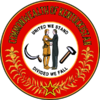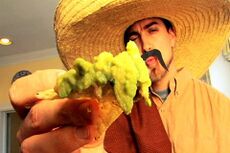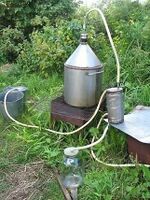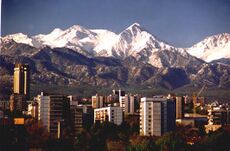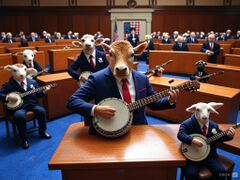Kentucky
The Bluegrass State The Commonwealth of Kentucky Kentucky | |||||
|---|---|---|---|---|---|
| |||||
| Motto: "It's finger-lickin' good!" | |||||
| Anthem: "My Old Kentucky Home" by Stephen Foster | |||||
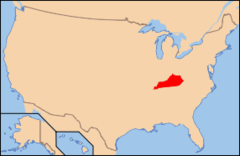 | |||||
| Capital | Frankfort | ||||
| Largest city | Louisville | ||||
| Official language(s) | Hillbilly, redneck | ||||
| Government | Commonwealth | ||||
| ‑ Governor | Andy Beshear | ||||
| ‑ Senators | Mitch McConnell Rand Paul | ||||
| National hero(es) | Colonel Sanders, Daniel Boone, Billy Ray Cyrus, George Clooney, Hunter S. Thompson, Jennifer Lawrence | ||||
| Major exports | Tobacco, enriched uranium, Southern belles, the Kentucky Derby, the Kentucky Rifle, Kentucky Bourbon (for drinking before firing your Kentucky Rifle), KFC | ||||
| Major imports | Virgins (female), clogging shoes | ||||
The Commonwealth of Kentucky is not a commonwealth at all, or even a wealth, but a state of the United States somewhat south of the Great Lakes region. It is a land of highs, such as the Appalachian Mountains; and lows, such as the Mississippi River. Between the highs and lows are an awful lot of middles, and nothing un-Common.
History
Beads and cubes
The first people who lived in what is now Kentucky were a tribe known as the Crap Throwers. Mounds of their crap can be found in every part of the state. Later, Indians such as the Iroquois and Delaware lived in Kentucky. By contrast, there were no Kentucky Indians living in Delaware. The Shawnee tribe built a center called Shawneetown. This was the state's first theme park and still its best tourist trap.
Penetrating Kentucky
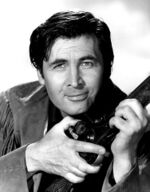
The white man first came to the area in 1634 in dribs and drabs. Little over a century later, the white flags came, as the French built the first settlement on the Ohio River. In 1750, Johnny Walker took a walk across Kentucky, after which he was red. In 1769, Daniel Boone came and stayed for two years. He returned with a group of settlers in 1773, but Indians killed several of the group, including Boone's son. Boone took the hint, but he returned in 1775 to have the last word, and build a highway. A fort along this road is named Boone's Farm in his honor. But it does not have a screw top.
The region began to be called Kentucky because it contained the Kentucky River. But no one knows why the Kentucky River began to be called that. Boone called it "Cuntucky, the Great Meadow," showing his tendency for vulgar humor, also his ignorance about how many great meadows there were elsewhere. He also thought it cute to give the state the postal code K-Y.
Baby steps at statecraft
In 1776, Kentucky became a county of the Commonwealth of Virginia. At about that time, of course, all Hell was breaking out with Great Britain, and Kentucky history took a breather. In 1792, tanned, rested, and ready, Kentucky convinced the U.S. it too could be a Commonwealth. It became the 15th state (commonwealth, whatever), with its capital in a town called Frankfort.
In 1798–99, it enacted the Kentucky and Virginia Resolutions. As well as giving Kentucky first billing, these acts opposed the Alien and Sedition Laws that Congress had passed in 1798. In contrast to the Constitution's Supremacy Clause, these acts told Congress, y'all can pass a law, and we'll tell you if we're fixin' to obey it. Copies of the Resolutions were sent to other states. They wrinkled their noses and read it aloud until they grasped its meaning. Then they told Kentucky it was a formula for chaos. Happily, nothing came of it, and both aliens and sedition thrived.
Its first attempt at statecraft bombing so awfully, Kentucky put its mind to growing tobacco, and then hemp. None of its other crops smoked nearly as well (except pigs). By 1865, Kentucky was America's top tobacco state. In contrast, buyers of the weak hemp stopped trying to get high off it at all, and used the leftovers in sailcraft. Kentucky's next endeavors were the whisky and thoroughbred horses by which we still know the state.
Antebellum gives way to Bellum
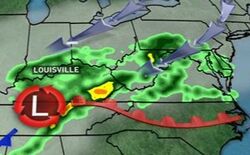
All Hell was ready to break out again, in the form of the Civil War. Owning slaves was a proud Kentucky tradition (not so proud among those owned), but Kentucky tried mightily to stay out of the war, even declining Abraham Lincoln's request that it do its "fair share". Locals imagined Kentucky as a neutral American Switzerland, hosting peace talks despite the locals' inscrutable accent — until both Union and Confederacy started recruiting Kentucky kids to fight.
Then the Rebels occupied the town of Columbus, hoping to string a chain across the entire Mississippi River and stop traffic. The legislature organized an army to make them pull out and go home. This had the unforeseeable effect of suggesting that Kentucky had cast its lot with the Union. Kentuckians fought as bravely as one can when one is completely undecided. The North won, but being nominally on the winning side did not spare Kentucky from having Union troops occupy it, boss everyone around, and free everyone's slaves without paying compensation. Ironically, Kentucky began to identify with the South as it never had before.
For whom the gate tolls
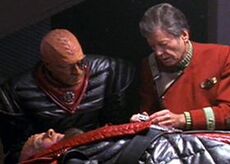
In 1894, Kentuckians started other wars less likely to have out-of-staters send "help". The first and most enduring was the Hatfield–McCoy War, between the McCoys of eastern Kentucky and the Hatfields of adjacent West Virginia. The casus belli were which side in the Civil War the combatants fought, who gets first billing in the name of the war, and what to do with a certain pig. The governors of both states weighed in; so did the U.S. Supreme Court regarding extradition. The results of the war were a network television mini-series, unmarked graves, and an allegory useful for any modern feud.
Following in swift succession was the Toll Gate War, fought to be able to drive on roads that other people had built and to blow right past the toll booths. Kentuckians won that war, as the state took over all the roads. Many of them went back to charging tolls, now collected by surly state employees who could file a grievance if you looked at them wrong. (Eventually, the bonds were paid off and the toll gates came down for good — unlike places like Massachusetts where they hurriedly issued new bonds to fund "repainting contracts.")
Yet another war, in 1906, was the Black Patch War. The Black Patch is the region where the best tobacco grows, and the farmers thought it would grow even better if they didn't all have to sell to a single group of dealers. The farmers won that war, an auction market was set up, and Kentucky was ready for some real fighting, in Europe.
Solid backing
Between the World Wars, the Great Depression hit Kentucky hard, but the U.S. Government moved to Fort Knox all the gold that gives value to the U.S. dollar. Like Kentucky's Wilderness Areas, you know it's there, though you can't touch it, and all seems right with the world. The dollar was changed so it is instead backed by Richard Nixon keeping his word, but the gold is all still right there, probably.
Geography
Kentucky is situated between the Midwestern and Southern United States. Its southern border with Tennessee really tries to be a straight line. Its borders with other states follow particularly squiggly rivers. It is a common lament that the districts for Kentucky's two U.S. Senators were gerrymandered by the other side to goose their vote. Kentucky is the only U.S. state to have continuous river boundaries on three sides (there being no way to do it on all four); however, in fairness, the other 49 states did not know there was a competition.
Eastern Kentucky is part of Appalachia, a mountainous region of the United States known for moonshine, incest, and double-wide trailers. Hilltop towns in this part of the state are separated by deep valleys. The language does not vary from town to town, but put-near. Clefts such as the Cumberland Gap let cultural refinement whoosh out and escape like a whistle through buck teeth. Coal is plentiful in this part of the state, notably in stockings at Christmas.
North-central Kentucky is known as the Bluegrass Region. Everyone knows grass is green, but Kentuckians don't. Horses don't either, but they don't care. They eat bluegrass and they listen to bluegrass. Tobacco grows in this region as well, but horses lay off that. It's not good for you. Most Kentuckians live in the Bluegrass Region. Politicians live in Frankfort; and sluggers live in Louisville. At the north edge of this region is Covington. It is a safe place to take in Cincinnati, Ohio and perhaps even write an Uncyclopedia article on it someday.
South-central Kentucky is known as the Pennyroyal Region. Pennyroyal is an herb and, unlike blue grass, actually exists. However, there is no lucrative market in pennyroyal, and tourists don't even come to look at it.
Western Kentucky is the lowest part of the state, descending to the Mississippi River. It includes a ten-square-mile piece of Fulton County that you can't even get to without someone else's permission.
Climate
Like most other places in the South, Kentucky has plenty of stifling heat and humidity. However, it is worse further south. Kentucky's oppressive weather is broken up by about 14 inches of snow per year, only not at the same time.
Culture
Cuisine
Kentucky has created a wide range of food and drink, such as bourbon, burgoo, and julep. However, the only item that is both well-known and under 50-proof is Kentucky Fried Chicken. This is the brainchild of Colonel Harland Sanders, a military cook now portrayed by a series of elderly actors from Scotland who can't get the accent right. Sanders perfected the art of giving chickens a Kentucky flavor (identified as salt and MSG), though recently appealing to out-of-state palates by dialing back the aroma of diesel fuel. In parts of the world where Kentucky, frying, chicken, or the English language are out-of-favor, the chain is known simply as KFC.
Kentucky chickens are aggressive, tenacious, and judgmental (less so after frying). In 1992, Billy Ray Cyrus had his achy heart broken when he was felled by a flock of them while filming a KFC commercial. Burt Reynolds was injured when he entered the fray to assist Cyrus. The commercial never aired.
Horsing around
None of Kentucky's cuisine is based on horse meat. Thus the horses that grazed on bluegrass for decades gave nothing back to the state. (Actually, they did return one thing, and no one seems interested in it.) Finally, Kentuckians thought it would be amusing to find out which ones ran the fastest. It was indeed so amusing that the Kentucky Derby is the first "jewel" in horse-racing's "Triple Crown", though technically, horses are allowed to race without derbies or any other headwear.
The next phase involved genetic modification, long before its condemnation by the United Nations. Horses were combined and recombined to breed faster and faster GMO-horses. The exercise held out hope of same-day Pony Express parcel delivery to California and beyond. Though society has since gone in the direction of jockeyless horses and driverless cars, out-of-state ownership of stables and prize race horses remains an investment that competes in security with modern alternatives such as Bitcoin and the market in Mexican New Peso futures.
Dance
Clogging is the official dance of Kentucky, and if you want to live to meet your grandchildren, you better get up and dance like your life depends on it. Because it does. Like language, clog dancing tells a story — a story about inbred honkies with little or no rhythm. Popularized by the nomadic drunk Scottish drifters who colonized the middle of the state during the Great Depression, it is only deadly in some situations, like when you have been clogging for weeks from too much bourbon.
Refuge for Tennesseeans
A little of Kentucky's economy and a lot of its culture consists of giving Tennessee residents options they do not have back home. For example, in the 1800s, two gentlemen could go to the Dueling Grounds in Franklin with their Kentucky Rifles and conduct a shooting contest while both were alive. Sam Houston survived adversaries there, long before he relocated to Texas and the only opponents were Mexicans. The Dueling Grounds were shut down in 1827 and, a century and a half later, reopened to offer Tennesseeans the tamer release of horse-related gambling. Between these eras, the only release offered to Tenneseeans relied on the fact that Kentucky girls are easier.
Education
Kentucky has eight four-year universities. Of these, the University of Kentucky and the University of Louisville are All That. The other six, not so much. These are regional universities, with curricula adapted to their region. For example, Western Kentucky University grants degrees in Cave Management, while Eastern Kentucky University teaches Hill Management. Morehead State University has one of the nation's few degrees in Space Science. Unfortunately, there are no space facilities in Kentucky, but most graduates are able to find their way to either Cape Canaveral or Houston, Texas without having to declare, "We have a problem."
Among private institutions, Transylvania University in Lexington offers degree work in Vampire Management.
Government
Kentucky government has included many colorful figures:
- John Y. Brown, Jr. owned several sports teams but surprised no one more than himself by starting a successful career in the Capitol. He is honored by the John Y. Brown, Jr. AA (Junior Alcoholics Anonymous) Highway near the non-Ohio side of the Ohio River.
- Andy Beshear has been the Governor of Kentucky since 2019. Matt Bevin defeated Beshear's father for the governorship in 2015, the year Beshear became Attorney General. In that role, he filed numerous lawsuits against the ticket of Bevin and Butt-Head. Bevin proved a very unpopular Governor, and Beshear won that title in a squeaker of a race. His most notable accomplishment as unpopular Governor has been to veto many bills passed by Republican legislators, and to watch them override his vetoes without working up a sweat.
- Mitch McConnell was the Republican Party leader in the U.S. Senate for several eons. When the Republicans were in the minority, McConnell showcased his inability to block legislation; whereas when they were in power, he showcased his inability to pass legislation. When Joe Biden was President and his son was a wholly-owned subsidiary of the Chinese government, McConnell kept Republicans from complaining, due to the Chao side of the family.
- Thomas Massie (pictured) represents Kentucky's 4th Congressional district. He is the only unabashed fan of ex-President Donald Trump whom Trump told the Party to expel. This occurred in 2020, when Massie insisted that representatives who wanted to pass Trump's Coronavirus "relief" bill fly back to Washington, D.C. and do it in person. Constituents were split, referring to Massie as either "sassy" or "pain-in-the-assie".
- Raylan Givens was recently elected as Governor. When legislators were informed that Raylan Givens was a fictional character from a TV show, they replied, "We doesn't care who he is, long as he ain't no foreigner."
| ||||||||||||||||||||
| Featured version: 30 December 2021 | |
| This article has been featured on the main page. — You can vote for or nominate your favourite articles at Uncyclopedia:VFH. | |

